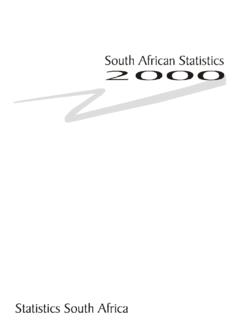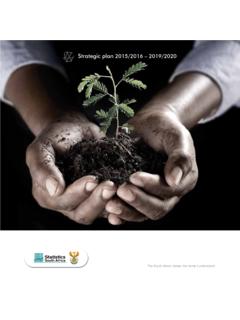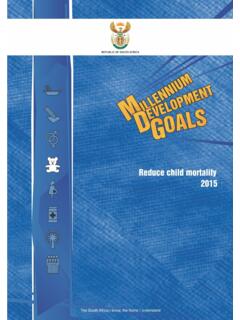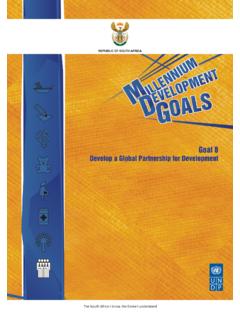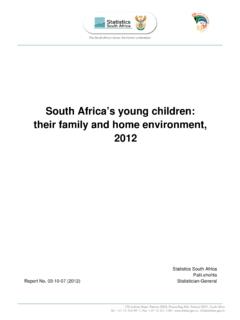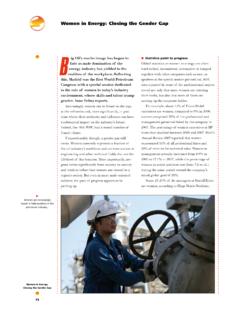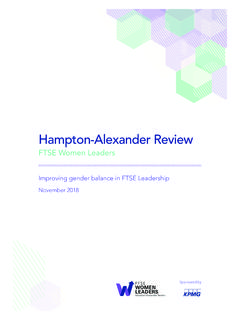Transcription of Statistics South Africa
1 Statistics South Africa Private Bag X44 Pretoria 0001 South Africa 170 Thabo Sehume (Andries) Street Pretoria 0002 User information services: (012) 310 8600 Fax: (012) 310 8500 Main switchboard: (012) 310 8911 Fax: (012) 321 7381 Website: Email: Editor s comment As we celebrate Women s Month in August, the South African government has made headway to promote gender equality and empowerment of women and closing the gap by increasing the proportion of seats allocated to women in parliament. The promotion of gender equality and women empowerment are part of the Millennium Development Goals (MDGs) which must be met by December 2015.
2 However, gender -based discrimination is still rife with regard to women s access to land and assets. According to the Organisation for Economic Co-operation and Development (OECD), which is a cross-country measure of discrimination against women in social institutions across 160 countries; formal and informal laws, social norms and practices, the absence of a national communal land tenure laws still leave many women who live in the former Bantustans or homelands vulnerable, as access to land strongly depends on relations to local power, which is usually vested in men.
3 OECD ranked South Africa at position 90 out of 148 countries in social institutions and gender index. Our educational article for this month s issue of Mbalo Brief focuses on the change in the use of electricity amongst households in South Africa . The findings in this article are based on the General Household Survey (GHS) Series V: Energy, 2002 2012 (Report No. 03-18-04). The article provides an analysis of access to electricity and changes in the households use of electricity. This issue also features articles on Land transport, Mining, Food and beverages and Tourism and Migration, amongst others.
4 Fill in our crossword puzzle to test your insight into general issues. We have also included the solutions to the July 2015 puzzle. Articles published in this issue are based on results of industry surveys conducted for the months ranging from April to July 2015, which were released in July and August 2015. For full details on any of our surveys, visit our website at Enjoy the read! i CONTENTS Editor s comment .. i Crossword puzzle ..iv Educational article on the change in the use of electricity amongst households in South Africa , 2002 - 2012.
5 1 Primary industries ..11 Mining: Production and sales ..11 Secondary industries ..13 Manufacturing: Production and sales ..13 Selected building Statistics of the private sector ..14 Electricity generated and available for distribution ..15 Tertiary industries ..17 Wholesale trade sales ..17 Retail trade sales ..18 Motor trade sales ..19 Food and beverages ..20 Tourist accommodation ..21 Tourism and migration ..23 Statistics of civil cases for debt ..25 Statistics of liquidations and insolvencies ..27 Land transport survey.
6 28 Prices ..30 Producer price index (PPI) ..30 Consumer price index (CPI) ..32 Glossary ..35 iii Crossword puzzle iv Across is the Commissioner of SouthAfrican Revenue Services? [Supplysurname only] many commercial ports doesSouth Africa has? [Read Landtransport survey article for clue] which city is the Constitutional Courtlocated? only negative annual growthrate was recorded for Motor tradesales? [Read Motor trade sales article] : Tourism Marketing SouthAfricaDown Chinese language willbe introduced in SouthAfrican schools in 2016?
7 Many parties arerepresented in South Africanparliament?Solutions for July 2015 puzzle Across Down 5. Mbethe8. Educational article on the change in the use of electricity amongst households in South Africa , 2002 2012 1. IntroductionEach household in South Africa requires an adequate amount of energy to conduct domestic chores such as cooking, heating, lighting and communicating. Having adequate access to appropriate forms of energy is critical for improving living standards, health and reducing poverty. In the absence of accessible or affordable modern energy, many households turn to multiple sources of energy, including fuels such as wood, cow dung and coal.
8 While some of these sources provide practical alternatives for household energy requirements, utilising them not only exposes households to health hazards but also contributes to environmental degradation. The use of these sources of energy is very common amongst low-income households and these households often spend a higher proportion of their household resources and time than wealthier households to acquire enough energy to maintain even modest household activities. Universal access to electricity is also one of the factors that the National Development Plan (NDP) seeks to achieve by 2030.
9 According to the plan, this will result in an elimination of poverty and a reduction of inequality. The plan states that this will be achieved by expanding access to energy (to 90% by 2020, and 95% by 2030), maintaining affordable tariffs, and maintaining targeted and sustainable subsidies for poor households. Although the plan acknowledges the significant achievements over the past 20 years, it points out that the energy needs of 20% or more of poor households still need to be met. The plan therefore calls for integrated plans to address energy deprivation where households either have no access to electricity, or where households can only afford modest quantities of electricity and are forced to use multiple sources of energy that are often costly and harmful.
10 The plan also warns that the reliability of electricity supply has deteriorated and that prices are rising at unaffordable rates. The purpose of this article is to provide an in-depth analysis of access of electricity and the change in the use of electricity over time. The findings in this article are based on the General Household Survey (GHS) Series V: Energy, 2002 2012 (Report No. 03-18-04), which was published in November 2013. This report is only updated once every four or five years; hence the data used is up to 2012.
